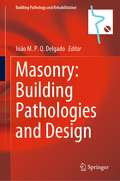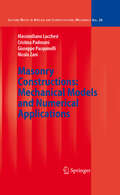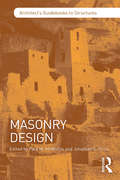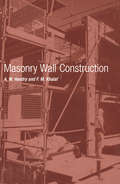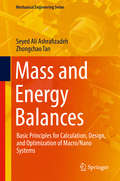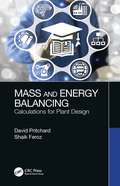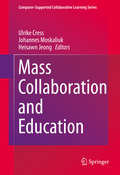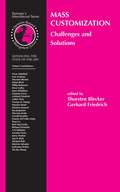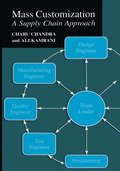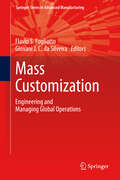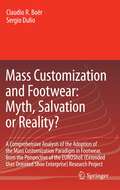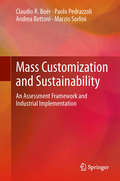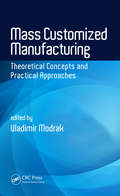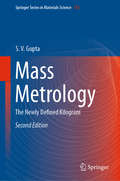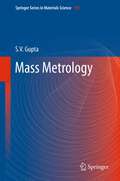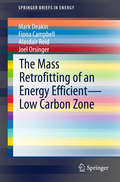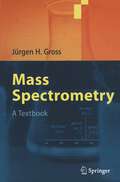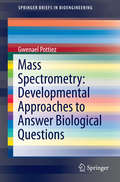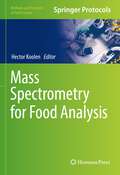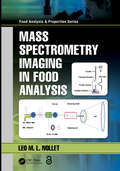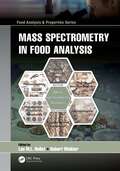- Table View
- List View
Masonry: Building Pathologies and Design (Building Pathology and Rehabilitation #22)
by João M. P. Q. DelgadoThis book presents a collection of recent research works related to blast resistant design, building pathologies, seismic coating, bottle-shaped concrete struts, delayed ettringite formation and waterproofing. It features eight chapters on building pathologies as well as a detailed set of references and suggestions for further reading. Offering a systematic review of the current state of knowledge, it is a valuable resource for scientists, students, practitioners, and lecturers in various scientific and engineering disciplines, including civil and materials engineering, as well as and other interested parties.
Masonry Constructions: Mechanical Models and Numerical Applications (Lecture Notes in Applied and Computational Mechanics)
by Massimiliano Lucchesi Cristina Padovani Giuseppe Pasquinelli Nicola ZaniMany historically and artistically important masonry buildings of the world’s architecturalheritageareindireneedofmaintenanceandrestoration.Inorder tooptimizesuchoperationsintermsofcost-e?ectiveness,architecturalimpact andstatice?ectiveness,accuratemodelsofthestructuralbehaviorofmasonry constructions are invaluable. The ultimate aim of such modeling is to obtain important information, such as the stress ?eld, and to estimate the extent of cracking and its evolution when the structure is subjected to variations in both boundary and loading conditions. Although masonry has been used in building for centuries, it is only - centlythatconstitutivemodelsandcalculationtechniqueshavebeenavailable that enable realistic description of the static behavior of structures made of this heterogeneous material whose response to tension is fundamentally d- ferent from that to compression. Important insights on the mechanical behavior of masonry arches and vaults come from as far back as Leonardo [10], Hooke [58], Poleni [92] and many other authors (see [47], [9] and [10] for detailed references). Castigliano, in his famous paper on the Mosca bridge [23], and Signorini, in his studies on masonry beams [97], [98], showed both the possibility and necessity of taking into account the weak tensile strength of masonry material.
Masonry Design (Architect's Guidebooks to Structures)
by Paul W. McMullin Jonathan S. PriceMasonry is found extensively in construction throughout the world. It is economical and strong. Masonry Design—part of the Architect’s Guidebook to Structures series—presents the fundamentals in an accessible fashion through beautiful illustrations, simple and complete examples, and from the perspective of practicing professionals with hundreds of projects under their belt and decades of teaching experience. Masonry Design provides the student with and reminds the practitioner of fundamental masonry design principles. Beginning with an intriguing case study of the Mesa Verde National Park visitor center, the subsequent chapters present the fundamentals of masonry design, bending, shear, compression design, wind and seismic design, and connection design. It is a refreshing change in textbooks for architectural materials courses and is an indispensable reference for practicing architects.
Masonry Design (Architect's Guidebooks to Structures)
by Paul W. McMullin Jonathan S. PriceMasonry is found extensively in construction throughout the world. It is economical and strong. Masonry Design—part of the Architect’s Guidebook to Structures series—presents the fundamentals in an accessible fashion through beautiful illustrations, simple and complete examples, and from the perspective of practicing professionals with hundreds of projects under their belt and decades of teaching experience. Masonry Design provides the student with and reminds the practitioner of fundamental masonry design principles. Beginning with an intriguing case study of the Mesa Verde National Park visitor center, the subsequent chapters present the fundamentals of masonry design, bending, shear, compression design, wind and seismic design, and connection design. It is a refreshing change in textbooks for architectural materials courses and is an indispensable reference for practicing architects.
Masonry Wall Construction
by A.W. Hendry F. M. KhalafThis volume provides a concise overview of the main facets of masonry wall construction, including materials, structural design, types of walls, movement, insulation, rain exclusion, site practice, defects and repair. The subject is covered in sufficient depth for a comprehensive introduction with reading lists after each chapter for those interest
Mass and Energy Balances: Basic Principles for Calculation, Design, and Optimization of Macro/Nano Systems (Mechanical Engineering Series)
by Seyed Ali Ashrafizadeh Zhongchao TanThis textbook introduces students to mass and energy balances and focuses on basic principles for calculation, design, and optimization as they are applied in industrial processes and equipment. While written primarily for undergraduate programs in chemical, energy, mechanical, and environmental engineering, the book can also be used as a reference by technical staff and design engineers interested who are in, and/or need to have basic knowledge of process engineering calculation. Concepts and techniques presented in this volume are highly relevant within many industrial sectors including manufacturing, oil/gas, green and sustainable energy, and power plant design. Drawing on 15 years of teaching experiences, and with a clear understanding of students' interests, the authors have adopted a very accessible writing style that includes many examples and additional citations to research resources from the literature, referenced at the ends of chapters.
Mass and Energy Balancing: Calculations for Plant Design
by David Pritchard Shaik FerozThe aim of this text is to provide a comprehensive set of calculations relating to mass and energy balances for an entire process plant. An ammonia synthesis plant will be taken as a calculation model to develop the relevant mass and energy balances necessary for the design and subsequent production, as the production of ammonia synthesis gas is an internationally used process. Instead of teaching the basics of mass and energy balances, the text aims to give a detailed series of process integrated and illustrated calculations to help readers develop and design a process plant. • Details complete mass and energy calculations related to a manufacturing plant and includes stepwise procedures for mass and energy balances • Demonstrates how the series of integrated calculations will lead to the production of a specified amount of final product • Features “teaching” appendices that lay out applications of prior-assumed knowledge, which can be used in conjunction with the main text where more detailed explanation may be needed • Contains problems linked to various manufacturing sections covered in the text to help readers consolidate their knowledge This book will serve undergraduate Chemical Engineering students as a teaching aid in capstone design and related courses and gives useful insights to advanced students, researchers, and industry personnel within the Chemical Engineering field.
Mass and Energy Balancing: Calculations for Plant Design
by David Pritchard Shaik FerozThe aim of this text is to provide a comprehensive set of calculations relating to mass and energy balances for an entire process plant. An ammonia synthesis plant will be taken as a calculation model to develop the relevant mass and energy balances necessary for the design and subsequent production, as the production of ammonia synthesis gas is an internationally used process. Instead of teaching the basics of mass and energy balances, the text aims to give a detailed series of process integrated and illustrated calculations to help readers develop and design a process plant. • Details complete mass and energy calculations related to a manufacturing plant and includes stepwise procedures for mass and energy balances • Demonstrates how the series of integrated calculations will lead to the production of a specified amount of final product • Features “teaching” appendices that lay out applications of prior-assumed knowledge, which can be used in conjunction with the main text where more detailed explanation may be needed • Contains problems linked to various manufacturing sections covered in the text to help readers consolidate their knowledge This book will serve undergraduate Chemical Engineering students as a teaching aid in capstone design and related courses and gives useful insights to advanced students, researchers, and industry personnel within the Chemical Engineering field.
Mass Collaboration and Education (Computer-Supported Collaborative Learning Series #16)
by Ulrike Cress Johannes Moskaliuk Heisawn JeongMass collaboration on Internet platforms like Wikipedia and Scratch, along with wider movements like the maker space and citizen science, are poised to have profound impacts on learning and education. Bringing together researchers from such fields as: psychology, education, information technology, and economics, the book offers a comprehensive overview of mass collaboration, novel, cross disciplinary, theoretical accounts, and methodological approaches for studying and improving these massively collaborative enterprises. The book is aimed to serve as an information source for researchers, educators, and designers of platforms and learning environments.
Mass Customization: Challenges and Solutions (International Series in Operations Research & Management Science #87)
by Thorsten Blecker Gerhard FriedrichThis book defines the parameters of the emerging business strategy of mass customization, covering the main categories in a systematic examination of: manufacturing systems and mass customization; supply chain management and mass customization; and information systems and mass customization. The book provides a conceptual framework for mass customization, its tools, its solutions, and real-world examples of successful implementations of the business strategy.
Mass Customization: A Supply Chain Approach
by Charu Chandra Ali K. KamraniMass Customization: A Supply Chain Approach is a text on the emerging topic of mass customization in manufacturing. The contributed chapters in this book provide a unified treatment to the topic by offering coverage in four main categories - concepts and current state of research; problem solving frameworks, models, and methodologies; supportive techniques and technologies for enabling mass customization; and future research agenda. The book blends theory and practice and includes prototypical applications to illustrate this complex, yet emerging field of inquiry.
Mass Customization: Engineering and Managing Global Operations (Springer Series in Advanced Manufacturing)
by Flavio S. Fogliatto Giovani J. C. Da SilveiraMass customization (MC) has been hailed as a successful operations strategy across manufacturing and service industries for the past three decades. However, the wider implications of using MC approaches in the broader industrial and economic environment are not yet clearly understood. Mass Customization: Engineering and Managing Global Operations presents emerging research on the role of MC and personalization in today’s international operations context. The chapters cover MC in the context of global industrial economics and operations. Moreover, the book discusses MC topics that are relevant to the manufacturing and service sectors, such as: • product platforms; • learning curve modeling; • additive manufacturing; and • service customization. Case studies in manufacturing (e.g., apparel and transportation) and services (e.g., banking and virtual worlds) are also included. Mass Customization: Engineering and Managing Global Operations is a valuable text for mass customization researchers and practitioners. Researchers will find a selection of chapters prepared by internationally renowned authors, comprising most of their recent research in MC. Engineering professionals will be drawn by the vivid discussion of operational aspects and methods of MC, as well as by the selection of cases illustrating their practical application.
Mass Customization and Footwear: A Comprehensive Analysis of the Adoption of the Mass Customization Paradigm in Footwear, from the Perspective of the EUROShoE (Extended User Oriented Shoe Enterprise) Research Project
by Claudio Roberto Boër Sergio DulioMass Customization and Footwear: Myth, Salvation or Reality is the only book dedicated to the application of mass customization in a particular industry. By showing examples of how a "mature" manufacturing sector like shoe making can be thoroughly renovated in business and mentality by applying this paradigm; Mass Customization and Footwear: Myth, Salvation or Reality will be bought by practitioners in the footwear sector and postgraduates, researchers and lecturers in the area of mass customization.
Mass Customization and Sustainability: An assessment framework and industrial implementation
by Claudio R. Boër Paolo Pedrazzoli Andrea Bettoni Marzio SorliniTo adapt to global competitive pressures, manufacturers must develop methods and enabling technologies towards a personalized, customer oriented and sustainable manufacturing. Mass Customization and Sustainability defines the two concepts of mass customization and sustainability and introduces a framework to establish a link between the two concepts to answer the questions: Are these two aspects empowering one another? Or are they hindering one another? These questions investigate mass customization as one of the main driving forces to achieve effective sustainability. A methodology to assess the contribution of mass customization to sustainability is developed, providing an assessment model composed by a set of indicators covering the three aspects of sustainability: social, economical and environmental. This is supported and further explained using ideas and new concepts compiled from recent European research. Researchers, scientists, managers and industry professionals alike can follow a set of practical examples and industrial cases, enabling them to easily transfer Mass Customization and Sustainability theoretical concepts into actions to be enforced into their everyday business for gaining competitiveness. Mass Customization and Sustainability also introduces useful concepts for government officials responsible for establishing sustainable policies and regulations, offering methods to compare the results of implementation of such policies.
Mass Customized Manufacturing: Theoretical Concepts and Practical Approaches
by Vladimir ModrakThis book brings several original contributions to research and practical applications in the field of mass customization from the designer, manufacturer, and customer perspectives respectively. It presents advancements in product design for mass customization, design of assembly and supply chain processes, variety induced complexity models, complexity management, marketing tools, information systems to support decision-making, and critical success factors of this manufacturing and marketing strategy.. A special focus of interest is also on the use of product configurators in practice and sustainability assessment for mass customization strategy. The aim is to disseminate current developments and approaches for further theoretical investigation and practical applications of mass customized manufacturing systems.
Mass Customized Manufacturing: Theoretical Concepts and Practical Approaches
by Vladimir ModrakThis book brings several original contributions to research and practical applications in the field of mass customization from the designer, manufacturer, and customer perspectives respectively. It presents advancements in product design for mass customization, design of assembly and supply chain processes, variety induced complexity models, complexity management, marketing tools, information systems to support decision-making, and critical success factors of this manufacturing and marketing strategy.. A special focus of interest is also on the use of product configurators in practice and sustainability assessment for mass customization strategy. The aim is to disseminate current developments and approaches for further theoretical investigation and practical applications of mass customized manufacturing systems.
Mass Metrology: The Newly Defined Kilogram (Springer Series in Materials Science #155)
by S. V. GuptaThis second edition of Mass Metrology: The Newly Defined Kilogram has been thoroughly revised to reflect the recent redefinition of the kilogram in terms of Planck’s constant. The necessity of defining the kilogram in terms of physical constants was already underscored in the first edition. However, the kilogram can also be defined in terms of Avogadro’s number, using a collection of ions of heavy elements, by the levitation method, or using voltage and watt balances. The book also addresses the concepts of gravitational, inertial and conventional mass, and describes in detail the variation of acceleration due to gravity. Further topics covered in this second edition include: the effect of gravity variations on the reading of electronic balances derived with respect to latitude, altitude and earth topography; the classification of weights by the OIML; and maximum permissible error in different categories of weights prescribed by national and international organizations. The book also discusses group weighing techniques and the use of nanotechnology for the detection of mass differences as small as 10-24 g. Last but not least, readers will find details on the XRCD method for defining the kilogram in terms of Planck’s constant.
Mass Metrology (Springer Series in Materials Science #155)
by S. V. GuptaThis book presents the practical aspects of mass measurements. Concepts of gravitational, inertial and conventional mass and details of the variation of acceleration of gravity are described. The Metric Convention and International Prototype Kilogram and BIPM standards are described. The effect of change of gravity on the indication of electronic balances is derived with respect of latitude, altitude and earth topography. The classification of weights by OIML is discussed. Maximum permissible errors in different categories of weights prescribed by national and international organizations are presented. Starting with the necessity of redefining the unit kilogram in terms of physical constants, various methods of defining the kilogram in terms of physical constants are described. The kilogram can be defined by Avogadro’s constant, ion collection of some heavy elements, levitation, voltage and Watt Balance. The detection of very small mass of the order of zeptogram through Nanotechnolgy is also discussed. Latest recommendations of CIPM are given.
The Mass Retrofitting of an Energy Efficient—Low Carbon Zone (SpringerBriefs in Energy)
by Mark Deakin Fiona Campbell Alasdair Reid Joel OrsingerMaximizing reader insights into the strategic value of mass retrofits in the residential property sector through a detailed case study analysis of the ‘Hackbridge project’, this book uses this development to broaden understanding of how planners may perform urban regeneration in accordance with a centralized plan.This book demonstrates how urban morphology matters, not only with respect to either the geometry of design and construction systems, or occupational behaviours, but with regards to the potential with which the planning, (re)development, design, construction, use and occupation of buildings, has to not only lower levels of energy consumption and rates of carbon emission, but also to reduce global warming associated with climate change.Delivering a critique of the state-of-the-art on urban morphology, the geometry of design typologies, construction systems and occupational behaviours and armed with the critical insights this offers, this book offers a context-specific analysis of how institutions can begin to actively plan for, integrate and sustain the development of energy efficient-low carbon zones.
Mass Spectrometry: A Textbook
by Jürgen H GrossMass Spectrometry is an ideal textbook for students and professionals as well as newcomers to the field. Starting from the very first principles of gas-phase ion chemistry and isotopic properties, the textbook takes the reader through the design of mass analyzers and ionization methods all the way to mass spectral interpretation and coupling techniques. Step-by-step, the reader learns how mass spectrometry works and what it can do. The book comprises a balanced mixture of practice-oriented information and theoretical background. It features a clear layout and a wealth of high-quality figures. Exercises and solutions are located on the Springer Global Web.
Mass Spectrometry: Developmental Approaches To Answer Biological Questions (SpringerBriefs in Bioengineering)
by Gwenael PottiezThe understanding of the events taking place in a cell, a biological fluid or in any biological system is the main goal of biology research. Many fields of research use different technology to assess those events. Mass spectrometry is one of those techniques and this undergoes constant evolution and adaptation to always enhance the accuracy of the information provided. Proteomics provides a large panel of data on protein identity and protein expression that were made possible by mass spectrometry. For several years now mass spectrometry has become central to performing proteomic research, however this powerful tool is under constant evolution to be more sensitive and more resolute. More importantly mass spectrometry became a field of research focusing on new applications. Indeed, the complexity in biological systems relies on the changes of expression of transcription of proteins but also on the post-translational modification of proteins, the structure of proteins and the interaction between proteins, amongst others. As of now, several investigations tried to improve the quantification of proteins by mass spectrometry, the determination of post-translational modifications, the protein-protein and protein-nucleic acids interaction or the proteins structures.This book is structured as follows: after a brief introduction of the usual and most popular applications for mass spectrometry in proteomics, the most recent research and developments in mass spectrometry-based methodologies will be explored.
Mass Spectrometry for Food Analysis (Methods and Protocols in Food Science)
by Hector KoolenThis volume details protocols on mass spectrometry and associated techniques. Chapters guide readers through micro- and macronutrients analysis, mass spectrometry-related methodologies, direct insertion, matrix-assisted laser desorption ionization (MALDI), gas chromatography (uni- and bi-dimensional), liquid chromatography, plasma mass spectrometry (ICP-MS), and analyses in food samples. Authoritative and cutting-edge, Mass Spectrometry for Food Analysis aims to provide comprehensive and updated state-of-art methodologies and models for food analysis.
Mass Spectrometry Imaging in Food Analysis (Food Analysis & Properties)
by Leo M.L. NolletFood contains various compounds and many technologies exist to analyze those molecules of interest. However, the analysis of the spatial distribution of those compounds using conventional technology, such as liquid chromatography-mass spectrometry or gas chromatography-mass spectrometry is difficult. Mass spectrometry imaging (MSI) is a mass spectrometry technique to visualize the spatial distribution of molecules, as biomarkers, metabolites, peptides or proteins by their molecular masses. Despite the fact that MSI has been generally considered a qualitative method, the signal generated by this technique is proportional to the relative abundance of the analyte and so quantification is possible. Mass Spectrometry Imaging in Food Analysis, a volume in the Food Analysis and Properties Series, explains how the novel use of matrix-assisted laser desorption/ionization mass spectrometry imaging (MALDI-MSI) will be an ideal complementary approach. MALDI-MSI is a two-dimensional MALDI-MS technology that can detect compounds in a tissue section without extraction, purification, separation, or labeling. It can be used to visualize the spatial distribution of biomolecules in foods. Features: Explains the novel use of matrix-assisted laser desorption/ionization mass spectrometry imaging in food analysis Describes how MALDI-MSI will be a useful technique for optical quality assurance. Shows how MALDI-MSI detects food contaminants and residues Covers the historical development of the technology While there are a multitude of books on mass spectrometry, none focus on food applications and thus this book is ideally suited to food scientists, food industry personnel engaged in product development, research institutions, and universities active in food analysis or chemical analysis. Also available in the Food Analysis and Properties Series: Food Aroma Evolution: During Food Processing, Cooking, and Aging, edited by Matteo Bordiga and Leo M.L. Nollet (ISBN: 9781138338241) Ambient Mass Spectroscopy Techniques in Food and the Environment, edited by Leo M.L. Nollet and Basil K. Munjanja (ISBN: 9781138505568) Hyperspectral Imaging Analysis and Applications for Food Quality, edited by N.C. Basantia, Leo M.L. Nollet, and Mohammed Kamruzzaman (ISBN: 9781138630796) For a complete list of books in this series, please visit our website at: www.crcpress.com/Food-Analysis--Properties/book-series/CRCFOODANPRO
Mass Spectrometry Imaging in Food Analysis (Food Analysis & Properties)
by Leo M. L. NolletFood contains various compounds and many technologies exist to analyze those molecules of interest. However, the analysis of the spatial distribution of those compounds using conventional technology, such as liquid chromatography-mass spectrometry or gas chromatography-mass spectrometry is difficult. Mass spectrometry imaging (MSI) is a mass spectrometry technique to visualize the spatial distribution of molecules, as biomarkers, metabolites, peptides or proteins by their molecular masses. Despite the fact that MSI has been generally considered a qualitative method, the signal generated by this technique is proportional to the relative abundance of the analyte and so quantification is possible. Mass Spectrometry Imaging in Food Analysis, a volume in the Food Analysis and Properties Series, explains how the novel use of matrix-assisted laser desorption/ionization mass spectrometry imaging (MALDI-MSI) will be an ideal complementary approach. MALDI-MSI is a two-dimensional MALDI-MS technology that can detect compounds in a tissue section without extraction, purification, separation, or labeling. It can be used to visualize the spatial distribution of biomolecules in foods. Features: Explains the novel use of matrix-assisted laser desorption/ionization mass spectrometry imaging in food analysis Describes how MALDI-MSI will be a useful technique for optical quality assurance. Shows how MALDI-MSI detects food contaminants and residues Covers the historical development of the technology While there are a multitude of books on mass spectrometry, none focus on food applications and thus this book is ideally suited to food scientists, food industry personnel engaged in product development, research institutions, and universities active in food analysis or chemical analysis. Also available in the Food Analysis and Properties Series: Food Aroma Evolution: During Food Processing, Cooking, and Aging, edited by Matteo Bordiga and Leo M.L. Nollet (ISBN: 9781138338241) Ambient Mass Spectroscopy Techniques in Food and the Environment, edited by Leo M.L. Nollet and Basil K. Munjanja (ISBN: 9781138505568) Hyperspectral Imaging Analysis and Applications for Food Quality, edited by N.C. Basantia, Leo M.L. Nollet, and Mohammed Kamruzzaman (ISBN: 9781138630796) For a complete list of books in this series, please visit our website at: www.crcpress.com/Food-Analysis--Properties/book-series/CRCFOODANPRO
Mass Spectrometry in Food Analysis (Food Analysis & Properties)
by Leo M.L. NolletThe quality and safety of food are crucial for human nutrition. However, evaluating the chemical composition of food is challenging for the analyst and requires powerful methods. Chromatography and mass spectrometry (MS) is the gold standard for analyzing complex food samples, including raw materials and intermediate and finished products. Mass Spectrometry in Food Analysis covers the MS-based analysis of different aspects of food quality, which include nutritional value, profile of macronutrients (proteins, lipids, and carbohydrates), micronutrients (vitamins), and nutraceutical active compounds. Additionally, sensory quality, flavor, food pigments, safety, and detection of pesticides, contact materials, veterinary drugs and pharmaceuticals, organic pollutants, and pathogens are covered. Key Features: Contains the basics of mass spectrometry and experimental strategies Explores determination of macro- and micronutrients Analyzes sensory and nutraceutical food quality Discusses detection of contaminants and proof of authenticity Presents emerging methods for food analysis This book contains an introductory section that explains the basics of MS and the difference between targeted and untargeted strategies for beginners. Further, it points out new analytical challenges, such as monitoring contaminants of emerging concern, and presents innovative techniques (e.g., ambient ionization MS and data mining). Also available in the Food Analysis & Properties Series: Nanoemulsions in Food Technology: Development, Characterization, and Applications, edited by Javed Ahmad and Leo M.L. Nollet (ISBN: 978-0-367-61492-8) Sequencing Technologies in Microbial Food Safety and Quality, edited by Devarajan Thangadurai, Leo M.L. Nollet, Saher Islam, and Jeyabalan Sangeetha (ISBN: 978-0-367-35118-2) Chiral Organic Pollutants: Monitoring and Characterization in Food and the Environment, edited by Edmond Sanganyado, Basil K. Munjanja, and Leo M.L. Nollet (ISBN: 978-0-367-42923-2) For a complete list of books in this series, please visit our website at: www.crcpress.com/Food-Analysis--Properties/book-series/CRCFOODANPRO
